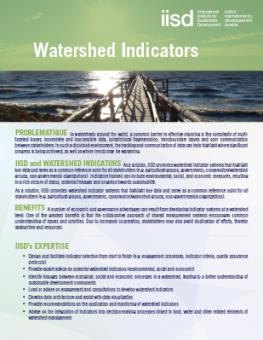
Watershed Indicators
A common barrier to effective planning In watersheds around the world is the complexity of the multi-faceted issues, incomplete and inaccessible data, jurisdictional fragmentation, transboundary issues and poor communication between stakeholders.
In such a disjointed environment, the tracking and communication of data can help highlight where significant progress is being achieved, as well as where trends may be worsening.
As a solution, IISD promotes watershed indicator systems that highlight key data and serve as a common reference point for all stakeholders (e.g., agricultural groups, governments, conservation/watershed groups, non-governmental organizations). Indicators tracked can include environmental, social, and economic measures, resulting in a rich picture of status, potential linkages and progress towards sustainability.
This brochure outlines IISD’s work with indicators, and describes the expertise possessed by the organization’s staff to collaborate with partners who wish to develop indicator sets and systems to visualize data or integrate indicators into decision making. Two examples provided of successful indicator initiatives include the sustainability indicator system for Lake Balaton (Hungary) and the “Peg” community indicator system in Winnipeg, Canada.
You might also be interested in
National State of the Environment Report: Uzbekistan
The National State of the Environment Report (NSoER) is a comprehensive document that provides a snapshot of current environmental trends in Uzbekistan's socio-economic development for citizens, experts, and policy-makers in the country of Uzbekistan.
Essential Monitor's Guide for Prairie Water Retention
This guidance document aims to make water retention monitoring a more accessible practice from a technical standpoint by demystifying some of the considerations required to get started.
Freshwater connectivity can transport environmental DNA through the landscape
A new study conducted at IISD-ELA found that the movement of water between freshwater bodies can transport eDNA which complicates the question of how accurately it can be used to monitor species.
Large Area Planning in the Nelson-Churchill River Basin (NCRB): Laying a foundation in northern Manitoba
This report explores two trends—the growing tendency towards large basin management and consideration of ecosystem services in decision making—for the northern portion of the Nelson-Churchill River Basin in Canada.